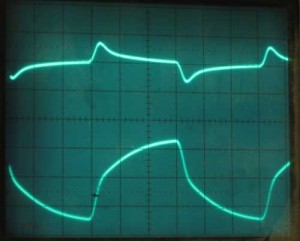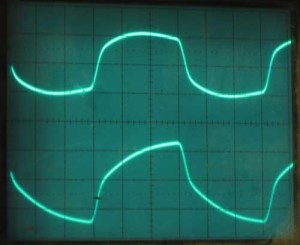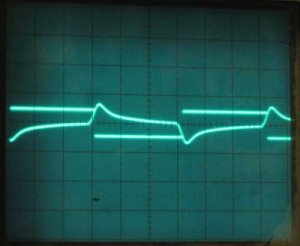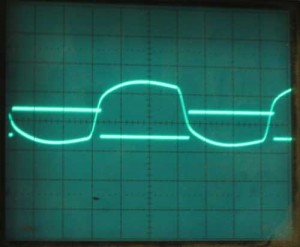Yesterday, I spent the good part of the day with the ACI and finally have a good fix that makes it far more robust without changing the board layout. In the past I had discovered that the Apple II cassette interface is far more reliable than the Apple 1 was. I did spice simulations of both and quite a bit of fooling around with the actual ACI in order to see if I could figure out the problem. The best improvement I could come up with, was to add a low pass filter on the input. This was done by adding a .01uF cap between the input side of the comparator and ground.
In revisiting the ACI yesterday, I finally discovered the real difference in the design that makes the Apple II so much more reliable. The Apple II uses a .1uF capacitor for input coupling versus a .01uF on the ACI. When I looked at this in the past, I must have forgotten to make this change when evaluating the designs with spice. This change provides a lot more noise immunity in the comparator inputs.
Here is the ACI input signal with the stock .01uF input coupling capacitor. The source of the signal is the 1HZ tone (all ones) at the front of Wendell Sanders Hammerabi clip being played from an iPod with the equalizer set to “treble reducer”. All signals are displayed at .5 volts/division on this page.

In the image, above, the input is the bottom signal and top signal is how it is presented to the comparator input after passing through the capacitor. Note how the signal spikes and then returns to the value set by the 10K resistors.

Above is the same input and output signals with a .1uF capacitor. The signal follows the shape of the input waveform much more closely. The bottom trace is input signal and is the same as in the first image. The top trace is input to comparator after passing through cap. Note how the extra capacitance prevents the resistors from quickly returning to the base value set by the resistors.

This image shows both inputs to the comparator with the stock .01uF capacitor. Spiky looking trace is input signal to comparator (same signal as seen in first image). Other trace is reference signal with hysterisis. The reference signal is pulled up and down slightly as the comparator switches state to prevent instability. This results in the square wave.
In the picture above, the output switches state when input signal (more spiky looking signal) passes the level of the reference signal as can be plainly seen in this image. The problem with this design is the limited amount of room between the input and the reference, any input noise with an amplitude of around .2 volts or more may be enough to trigger a switch in output levels.
Below are the same two inputs to the comparator with the .1uF cap. This wave form increases noise immunity to almost a volt, about 5 times improvement over the apple 1 stock implementation.

Unless you are interested in maintaining complete commonality with the original Apple 1, I highly recommend using a .1uF capacitor in your replica cassette interface instead of the .01uF used in the original design. Keep in mind that the folks at Apple recognized this improvement before coming out with the Apple II, as that design includes .1uF cap for this application.
Since I was using a clone ACI, built with components based on the schematics, I wondered if Apple actually shipped with .1uF caps on the ACI. I exchanged a couple of emails with Wendell Sander. He confirmed that the schematics are correct and the Apple ACI did indeed ship with a .01uF caps. He also confirmed that he had independently come to the same conclusion regarding the reliability improvement that could be attained with a .1uF cap.

NIce work Mike. I haven’t built my 2 kits yet, but will go ahead and replace each cap when I do.
Pingback: Apple Cassette Interface Installed « Apple-1.org